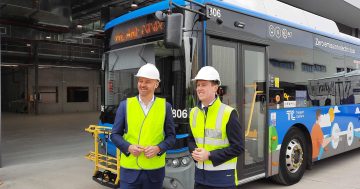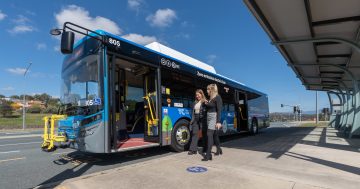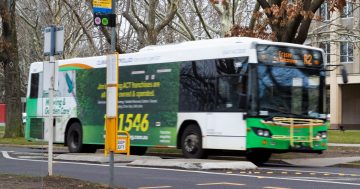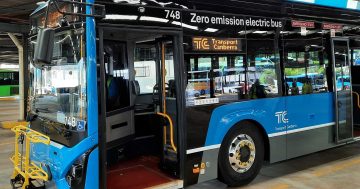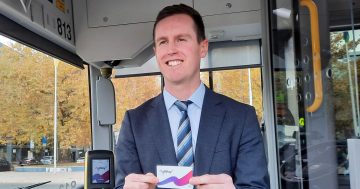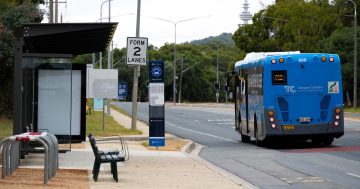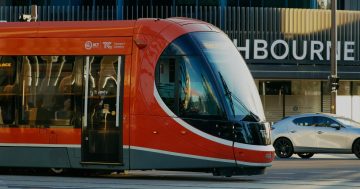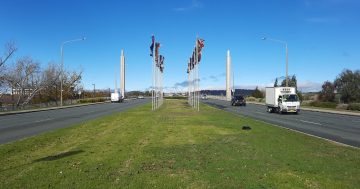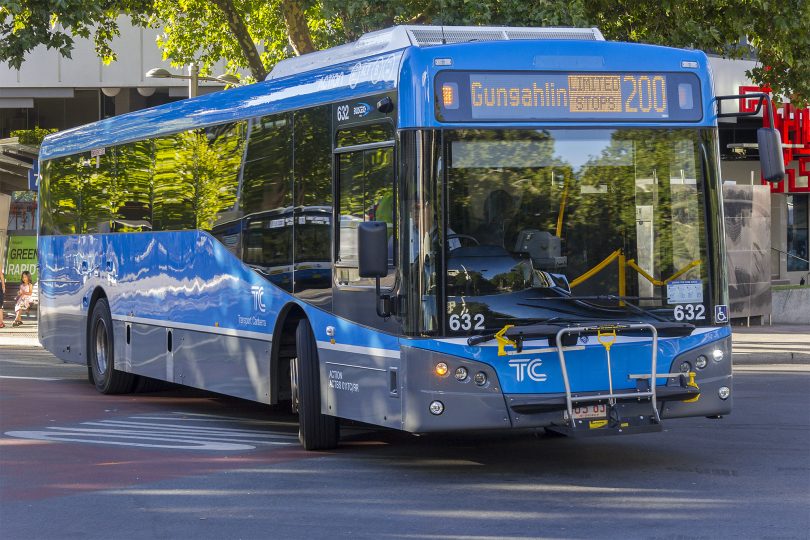
More frequent, faster and better connected: that’s what the ACT Government is promising after sweeping changes to the transport network. Photo: File.
The postponed sweeping update to the ACT’s public transport network will be rolled out from 18 July and include more frequent and faster services in a bid to smooth out the wrinkles in its original design.
The COVID-19 pandemic disrupted the timetable for the wide-ranging update’s original launch in April, and the roll-out is timed to coincide with recovery plans and people returning to work and their offices.
It is also the weekend before the start of Term 3, which allow the network to bed down before the restart of school.
There will be four new school services – three in Gungahlin and one in Tuggeranong – as well as modifications to some services.
The updated network includes more local services, with 30-minute frequencies on weekdays instead of every hour, more direct Rapid services and scrapping of the loops in Gungahlin and Tuggeranong that made for longer journey times and so incensed commuters.
The aim is also to make it easier for Canberrans to avoid the peaks and spread their travel across the day.
Minister for Transport Chris Steel said the updated network, based on community feedback and analysis of travel data, would provide 692 extra bus services each weekday, up 17.5 per cent from 4132* to 4824, most of which will be local runs.
“As some Canberrans gradually return to work during Step 3 of recovery, we will be implementing an improved bus system with more services on key routes to help avoid crowding,” he said.
“Our advice still remains the same about public transport, which is to avoid travel in peak times. However, implementing this update to the bus network will assist in supporting those who need to use public transport.”
The number of light rail services will also increase from 18 July, with the frequency rising to every five minutes and Sunday services starting from 7:00 am.
There will be 55 extra weekend bus services from 18 July and this will increase by a further 236** from the beginning of Term 4, or earlier, once driver training had been completed, following delays to face-to-face training during the pandemic.
Transport Canberra says the update will mean better coverage of Taylor, Denman Prospect, Wanniassa, Giralang and McKellar, with services better connected and timetables for routes that serve the same area better coordinated to improve connections and reduce waiting times for passengers.
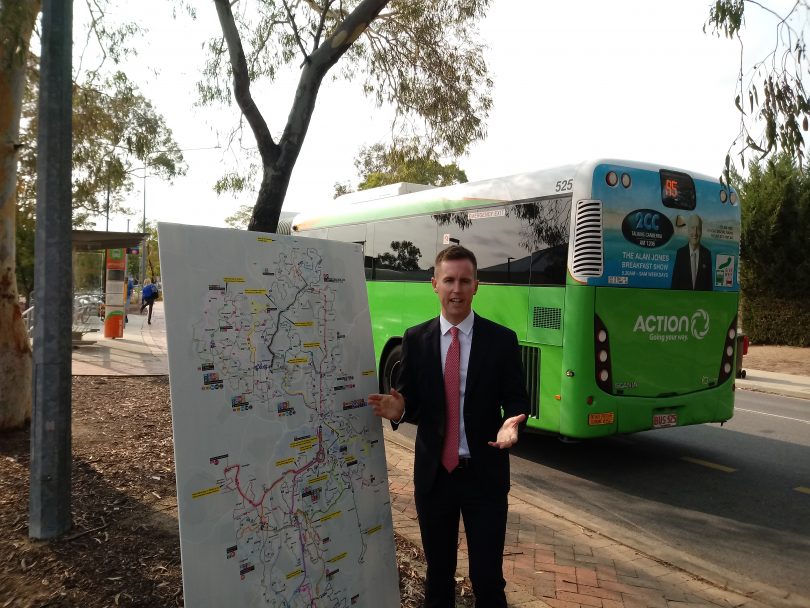
Transport Minister Chris Steel in Calwell last February discussing the network changes and a driver recruitment campaign. Photo: File.
In Tuggeranong, there will be travel time savings of about 20 minutes from Lanyon to the City for passengers using Rapid 5, which will run every 10 minutes all day on weekdays.
The Rapid 4 will also no longer terminate at Woden but will continue on to Tuggeranong.
Three local routes – 72, 76 and 77 – will provide direct services from Tuggeranong suburbs through to the Canberra Hospital and Woden.
In Wanniassa, route 73 will stop on Kirkton Street, Gaunson Cresent, Longmore Crescent and Sainsbury Street.
“More peak buses will be provided back to Tuggeranong each afternoon from the City and Barton to Lanyon Valley, Kambah, Chisholm and Calwell, giving passengers more flexibility about when they leave work,” Mr Steel said.
For Woden, Weston Creek and Molonglo, the Rapid 10 (Molonglo to City) service will run every 15 minutes at peak times, and the Rapid 4 and Rapid 5 will both take the most direct route from Woden to the City.
A new frequent local route 59 will run from Woden to Forrest, Barton and Russell every 15 minutes on weekdays.
In the inner city, four minutes each way has been shaved off Rapid 9 between Dickson and Belconnen, while Route 902 will run directly from Old Narrabundah to the Woden Town Centre, seven days a week to reduce the need to change buses.
In Belconnen, about nine minutes has been cut from the morning commute on route 41 from Charnwood, Flynn and Melba to Belconnen, and services on route 32 (Belconnen to City via Jamison) will run every 10 minutes at the busiest times.
There will also be new services through Giralang, Kaleen and McKellar connecting to Gungahlin and Belconnen.
In Gungahlin, there will be local bus services from Crace, Palmerston and Nicholls to the Belconnen Town Centre to reduce the need to change buses, and Route 18 will be extended to Dickson, reducing the need for passengers to make multiple transfers and making it easier to get to Mitchell from Belconnen and the inner north.
Whether parents and schools will be happy with the changes to their services remains to be seen, but transport officials say some of the network changes will also benefit students, such as more Rapid 6 services stopping at Narrabundah College.
Other changes include:
- Additional school specials, including new routes and extra buses on busy school specials at schools such as Amaroo School, Good Shepherd Primary, Red Hill School and Melrose High School
- Extended school specials, with some services extended to provide a service to more students for schools like St Edmund’s College and Calwell High School
- Faster school specials to save time for families each day, at schools like St Francis Xavier College and Radford College
- Adjusted timetables to match bell times at schools like Giralang Primary and Lyneham High School, and
- Changes to bus stops to make it easier for students to catch a bus from schools like St Monica’s Primary and Telopea Park School.
Public transport patronage has begun to rise again after it collapsed at the height of COVID-19 concerns with journeys more than tripling from 39,647 (WC 6 April) to 136,351 last week (WC 15 June).
But transport officials are playing a long game, saying the recovery will take a couple of years not months.
Journeys had been rising steadily over the past three years and 16.5 million had been projected for this year, only for COVID-19 to slash that to 12.4 million.
To see the full timetables and detailed regional improvements, visit Transport Canberra.
* Corrected from 3662, which is the pre-Network 19 figure.
** Correcting the increase in the number of overall weekend services.












